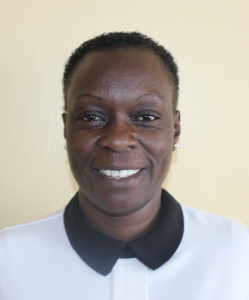St. Teresa's Isanjiro Girls Secondary School was founded in 2013 by the local Catholic church community, area leaders, and other community members. Their main goal was to take care of the "education of the girl child". Most members of the community here are very poor and live below the poverty line, hence they could not afford to send their children to boarding school. Starting with a population of 50 students, the school has since grown to its current group of 300 students and 26 teachers and staff.
The school is located in a quiet and peaceful area that is part rural, part urban. Buildings in the area are a mix of traditional mud walls and iron sheets, grass-thatched, and few modern houses. The area is characterized by gently sloping land with loamy clay soil, good for brickmaking. The main crop grown is maize.
The girls who attend St. Theresa's are considered to be a very vulnerable population. A majority of the pupils are either orphans, belong to single parents, or are being raised by their grandparents. These circumstances combined with the high prevalence of poverty often make the girls' education very difficult with so many hurdles to overcome. Not least of which is the fact that students still do not have sufficient access to clean and safe water.
The water crisis at St. Teresa's Isanjiro Girls Secondary School means that students are forced to walk to an unprotected spring which they share with community members to fetch water. Piped water is also available for just several hours each week, though sometimes it does not turn on at all and the standpipe is not located on school grounds. The school does have a small plastic rain tank, but it can only collect up to 5,000 liters of water and is hardly sufficient for their needs.
Sometimes the need for water is so great, students will even fetch it from a shallow stream in the community, providing water that is muddy, open to surface runoff, animal manure, and all sorts of contaminants. The combination of all of these unreliable, distant, or unsafe water sources means that students here are suffering from missed class time while fetching water, and absenteeism due to waterborne illnesses such as diarrhea.
"As a girl child, my water requirements are high but are not adequately met by [the] unprotected spring and piped water. I spend more time looking for water, [and] that's affecting my study time," explained 17-year-old student Catherine.
The students are not the only ones affected.
"As the teacher on duty, I have to personally supervise the students as they go out of the school to fetch water. This interferes with my other duties and responsibilities at the school," said teacher Mr. Vincent Opalo.
The combination of students' missed class time and teachers' lack of prep time means that classes are not as productive, focused, or well-attended as they could be, hindering students' academic performance.
A typical day sees students arriving at school at 7:00 am to start cleaning the latrines, classrooms, and school compound. They go into morning classes until 10:00 am when they either have a 15-minute tea break or must go to the spring to fetch water. The trek to the spring takes much longer than the 15 minutes allotted, however, so on these days the students are often quite late for their next 2 lessons that run until 12:45 pm. At that point, they break for lunch up to 2:00 pm, when again some students may be sent to the spring to fetch water after eating. From 2:00 pm to 3:45 pm they have 2 more classes, followed by games.
The day ends at 4:30 pm unless they have run out of water again. In that case, students are sent yet again to fetch more water for the following day's drinking, cleaning, washing, and cooking. Then, it is time to go home before the cycle repeats the next morning.
What we can do:
Rain Tank
A 75,000-liter rainwater catchment tank will help alleviate the water crisis at this school. The school will help collect the needed construction materials such as sand, bricks, rocks, and water for mixing cement. We will complement their materials by providing an expert team of artisans, tools, hardware, and the guttering system. Once finished, this tank will begin catching rainfall that will be used by the school’s students and staff for drinking, handwashing, cooking, cleaning, and much more.
We and the school strongly believe that all of these components will work together to improve standards at this school, which will help lead to better student academic performance and will help unlock the opportunity for these students to live better, healthier lives.
Handwashing Stations
There is currently just 1 handwashing station for teachers, but nowhere for students to wash their hands after using the latrines or before eating lunch, let alone the water to do so.
The student health club will oversee the 2 new handwashing stations we will provide, and make sure they are kept clean and in working condition. The club leaders will fill the handwashing stations with water daily and make sure they are always supplied with a cleaning agent such as soap or ash.
VIP Latrines
The school has just 6 toilets that serve all 300 pupils. That means that on average, 1 toilet serves about 50 girls. More toilets will enhance convenience for the girls whose hygiene and sanitation requirements are unique compared to boys.
2 triple-door latrine blocks will be constructed with local materials that the school will help gather. All of these new latrines will have cement floors that are designed to be easy to use and to clean. And with a rain tank right on school property, there should be enough water to keep them clean.
Training
We will hold a 1-day intensive training on improved hygiene, health, and sanitation habits at this school. Our team of facilitators will use a variety of methods to train students and staff, including participatory hygiene and sanitation transformation (PHAST) and asset-based community development (ABCD). We will initiate a child-to-child (CTC) student health club, which will prepare students to lead other pupils into healthy habits at school and at home. We will also lead lectures, group discussions, and provide illustrative handouts to teach health topics and ways to promote good hygiene practices within the school. We will then conduct a series of follow-up trainings before transitioning to our regularly scheduled support visits throughout the year.

 Rainwater Catchment
Rainwater Catchment
 Rehabilitation Project
Rehabilitation Project


















































